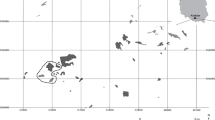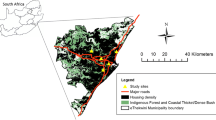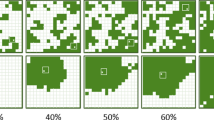Abstract
The goals of this study were to examine whether subjective habitat types may be segregated based on environmental variables and whether the relative influences of environmental factors on patch occupancy differ among habitat types. We examined these questions using a metapopulation of the butterfly Speyeria nokomis carsonensis, surveying sites for environmental characteristics and butterfly presence/absence over a 2-year period. Discriminant function analyses correctly classified 84% of sites within habitat types based on environmental variables that explained 82 and 67% of the variance along two ordination axes. Occupancy models for each habitat type demonstrated that the relative influences of environmental factors differed among habitat types. This study broadens the current paradigm of metapopulation dynamics by demonstrating that systems exist in which distinct habitat types can be delineated and differential suites of environmental factors explain occupancy according to habitat type. These findings demonstrate that even for highly specialized species, all habitat areas cannot be assumed to contribute equally to occupancy status, and thus have comparable conservation value. Designing land-use plans and policies based, in part, on careful habitat assessments can have important implications for the conservation of species existing in patchy landscapes, and can help guide reserve design, management actions, and allocation of resources on multiple-use landscapes.




Similar content being viewed by others
References
Austin GT (1998) New subspecies of Nymphalidae (Lepidoptera) from Nevada and Arizona. In: Emmel TE (ed) Systematics of western North American butterflies. Mariposa Press, Gainsville
Boughton DA (1999) Empirical evidence for complex source-sink dynamics with alternative states in a butterfly metapopulation. Ecology 80:2727–2739
Bradford DF, Neale AC, Nash MS, Sada DW, Jaeger JR (2003) Habitat patch occupancy by toads (Bufo punctatus) in a naturally fragmented desert landscape. Ecology 84:1012–1023
Britten HB, Brussard PF, Murphy DD, Austin GT (1994) Colony isolation and isozyme variability of the western seep fritillary, Speyeria nokomis apacheana (Nymphalidae), in the western Great Basin. Great Basin Nat 54:97–105
Britten HB, Fleishman E, Austin GT, Murphy DD (2003) Genetically effective and adult population sizes in the Apache silverspot butterfly, Speyeria nokomis apacheana (Lepidoptera: Nymphalidae). West N Am Nat 63:229–235
Burnham KP, Anderson DR (2002) Model selection and multimodel inference: a practical information-theoretic approach. 2nd edn. Springer, New York
Campbell SP, Clark JA, Crampton LH, Guerry AD, Hatch LT, Hosseini PR, Lawler JJ, O’Connor RJ (2002) An assessment of monitoring efforts in endangered species recovery plans. Ecol Appl 12:674–681
Dennis RLH, Eales HT (1999) Probability of site occupancy in the large heath butterfly Coenonympha tullia determined from geographical and ecological data. Biol Conserv 87:295–301
Dennis RLH, Shreeve TG, Van Dyck H (2003) Towards a functional resource-based concept for habitat: a butterfly biology viewpoint. Oikos 102:417–426
Dennis RLH, Hardy PB, Shreeve TG (2008) The importance of resource databanks for conserving insects: a butterfly biology perspective. J Insect Conserv 12:711–719
Diffendorfer JE (1998) Testing models of source–sink dynamics and balanced dispersal. Oikos 81:417–433
Fleischman E, Launer AE, Weiss SB, Reed JM, Boggs CL, Murphy DD, Ehrlich PR (2000) Effects of microclimate and oviposition timing on prediapause larval survival of the Bay checkerspot butterfly, Euphydryas editha bayensis (Lepidoptera: Nymphalidae). J Res Lepidoptera 36:31–44
Fleishman E, Ray C, Sjorgren-Gulve P, Boggs C, Murphy D (2002) Assessing the roles of patch quality, area, and isolation in predicting metapopulation dynamics. Conserv Biol 16:706–716
Gerber LR, Hatch LT (2002) Are we recovering? An evaluation of recovery criteria under the US Endangered Species Act. Ecol Appl 12:668–673
Hanski I (1994) A practical model of metapopulation dynamics. J Anim Ecol 63:151–162
Hanski I (1998) Metapopulation dynamics. Nature 396:41–49
Hanski I (1999) Metapopulation ecology. Oxford University Press, Oxford
Hanski I, Gilpin M (1991) Metapopulation dynamics: brief history and conceptual domain. Biol J Linn Soc 42:3–16
Hanski I, Gaggiotti OE (2004) Ecology genetics and evolution of metapopulations. Elsevier Academic Press, Boston
Hanski I, Ovaskainen O (2003) Metapopulation theory for fragmented landscapes. Theor Popul Biol 64:119–127
Harrison S, Murphy DD, Ehrlich PR (1988) Distribution of the Bay checkerspot butterfly, Euphydryas editha bayensis: evidence for a metapopulation model. Am Nat 132:360–382
Inc SPSS (2000) SYSTAT for Windows. Version 10. SPSS Inc., Chicago
Johnson JB, Omland KS (2004) Model selection in ecology and evolution. Trends Ecol Evol 19:101–108
Kreuzer MP, Huntly N (2003) Habitat-specific demography: evidence for source–sink population structure in a mammal, the pika. Oecologia 134:343–349
Lattin J, Carroll JD, Green PE (2003) Analyzing multivariate data. Brooks/Cole–Thomson Learning, Inc., Toronto
Manly BFJ (1997) Randomization, bootstrap and Monte Carlo methods in biology, 2nd edn. Chapman and Hall, Florida
Moilanen A (1999) Patch occupancy models of metapopulation dynamics: efficient parameter estimation using implicit statistical inference. Ecology 80:1031–1043
Moilanen A, Hanski I (1998) Metapopulation dynamics: effects of habitat quality and landscape structure. Ecology 79:2503–2515
Pellet J, Fleishman E, Dobkin DS, Gander A, Murphy DD (2007) An empirical evaluation of the area and isolation paradigm of metapopulation dynamics. Biol Conserv 136:483–495
Pulliam HR (2000) On the relationship between niche and distribution. Ecol Lett 3:349–361
Quinn GP, Keough MJ (2002) Experimental design and data analysis for biologists. Cambridge University Press, Cambridge
Reed M (1996) Using statistical probability to increase confidence of inferring species extinction. Conserv Biol 10:1283–1285
Sada DW, Fleishman E, Murphy DD (2005) Associations among spring-dependent aquatic assemblages and environmental and land use gradients in a Mojave Desert mountain range. Divers Distrib 11:91–99
Sanford MP (2010) Conservation status and management of the imperiled Carson Valley silverspot butterfly Speyeria nokomis carsonensis (Lepidoptera: Nymphalidae) based on rapid assessments of distribution, habitat, and threats. J Insect Conserv. doi:10.1007/s10841-010-9371-6
SAS (2003) Version 9.1.3 for Windows. SAS Institute Inc., Cary
Settele J, Shreeve T, Konvicka M, Van Dyck H (2009) Ecology of butterflies in Europe. Cambridge University Press, Cambridge
Singer MC, Thomas CD (1996) Evolutionary responses of a butterfly metapopulation to human- and climate-caused environmental variation. Am Nat 148:S9–S39
Sjogren P (1991) Extinction and isolation gradients in metapopulations: the case of the pool frog (Rana lessonae). Biol J Linn Soc 42:135–147
Sjogren P (1994) Distribution and extinction patterns within a northern metapopulation of the pool frog, Rana lessonae. Ecology 75:1357–1367
Talley TS, Fleishman E, Holyoak M, Murphy DD, Ballard A (2007) Rethinking a rare-species conservation strategy in an urban landscape: the case of the valley elderberry longhorn beetle. Biol Conserv 35:21–32
Tear TH, Scott JM, Hayward PH, Griffith B (1993) Status and prospects for success of the Endangered Species Act—a look at recovery plans. Science 262:976–977
Thomas CD, Hanski I (1997) Butterfly metapopulations. In: Hanski I, Gilpin ME (eds) Metapopulation biology: ecology, genetics, and evolution. Academic Press, San Diego, pp 359–386
Turlure C, Choutt J, Van Dyck H, Baguette M, Schtickzelle N (2010) Functional habitat area as a reliable proxy for population size: case study using two butterfly species of conservation concern. J Insect Conserv 14:379–388
Vos CC, Stumpel AHP (1995) Comparison of habitat-isolation parameters in relation to fragmented distribution patterns in the tree frog (Hyla arborea). Landscape Ecol 11:203–214
Wilcox BA, Murphy DD (1985) Conservation strategy: the effects of fragmentation on extinction. Am Nat 125:879–887
Xu D, Feng Z, Allen LJS, Swihart RK (2006) Spatially structured metapopulation model with patch dynamics. J Theor Biol 239:469–481
Acknowledgments
We thank all of the private landowners who permitted us with land access to conduct this research. R. Inman provided assistance with GIS, Great Basin Bicycles provided materials for backcountry travels, J. Baldwin provided SAS programming assistance, and Kyu Duki Park provided various technical assistance. The manuscript benefited from comments by N. Dochtermann, M. Haworth, N. Huntly, and two anonymous reviewers. This research was partially funded by grants through the University of Nevada’s Biology Department and the Nevada Biodiversity and Conservation Initiative.
Author information
Authors and Affiliations
Corresponding author
Rights and permissions
About this article
Cite this article
Sanford, M.P., Murphy, D.D. & Brussard, P.F. Distinguishing habitat types and the relative influences of environmental factors on patch occupancy for a butterfly metapopulation. J Insect Conserv 15, 775–785 (2011). https://doi.org/10.1007/s10841-011-9376-9
Received:
Accepted:
Published:
Issue Date:
DOI: https://doi.org/10.1007/s10841-011-9376-9




